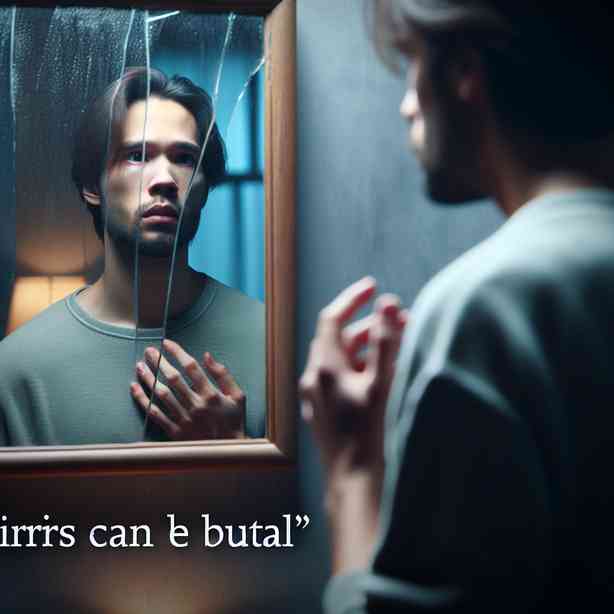
Mirrors have been a part of human civilization for thousands of years, serving various purposes, from practical uses in grooming to their symbolic representations in literature and philosophy. However, while they allow us to see our outer selves, they can also reflect back profound truths about our inner lives. This reflection can sometimes be brutal, revealing not only our physical attributes but also our insecurities, fears, and the societal pressures we often choose to ignore.
The experience of looking in a mirror can elicit a wide range of feelings. For some, it is a moment of self-affirmation, while for others, it can become an agonizing ordeal. The image we see staring back at us can serve as a reminder of our perceived failures, unfulfilled desires, or even the passage of time. This exploration into our reflections reveals how deep-seated emotions are intricately tied to our self-image.
From a psychological standpoint, mirrors can act as instruments of self-reflection. The concept of self-awareness has been studied extensively, with mirrors serving as a catalyst for individuals to confront and analyze their thoughts and feelings. When we look in a mirror, we are not merely observing our physical form; we are often forced to confront the things we may not want to accept. This confrontation can lead to critical self-realizations, which, while often uncomfortable, are necessary steps in personal growth.
Moreover, societal standards of beauty and success play a significant role in how we perceive ourselves in mirrors. The media bombards us with images that set unrealistic expectations, creating a disparity between how we look and how we “should” look according to these standards. This can lead to negative body image, self-esteem issues, and even severe mental health problems, such as eating disorders or depression. When we face a mirror, we can find ourselves grappling with these imposed ideals, leading to a brutal reckoning with the self.
On a deeper level, mirrors have symbolic meanings in various cultures and philosophies. In many traditions, the mirror serves as a metaphor for truth and insight. The act of looking into a mirror is often portrayed as a journey inward, a way to uncover deeper truths about oneself. The brutal nature of this exploration lies in the fact that, often, the truths revealed can be uncomfortable and challenging to face.
Additionally, mirrors can act as a narrative tool in literature and art, symbolizing the complexity of identity, duality, and even the subconscious. Characters looking into mirrors often experience moments of revelation or crisis, confronting their true selves. These portrayals resonate with readers and viewers because they reflect the universal human experience of coming to terms with who we are versus who we aspire to be.
Furthermore, the concept of self-perception also extends beyond physical attributes. Many individuals struggle with internalized beliefs that emerge from their reflections. The mirror can become a battleground of thoughts where the war between self-love and self-loathing takes place. For instance, someone might look in the mirror and be overwhelmed with self-doubt, wondering if they measure up to their own expectations, family expectations, or societal standards. Such thoughts can perpetuate a cycle of negativity, reinforcing harmful belief systems about oneself.
On the flip side, mirrors can also serve as powerful instruments for positive affirmations. The practice of standing in front of a mirror and speaking kindly about oneself can alter negative thought patterns. When individuals consciously shift their focus to gratitude for what their bodies can do rather than how they appear, the mirror transforms from a device of brutality into a symbol of self-acceptance and love. This duality—both brutal and affirming—makes mirrors complex objects in our emotional landscapes.
Moreover, in a world consumed by social media, mirrors take on a new role. People curate their images and project idealized versions of themselves online, often leading to further disconnect when faced with their unfiltered reflections. The contrast between the polished images presented on social media and the raw reality seen in the mirror can lead to feelings of inadequacy and dissatisfaction. This phenomenon underscores how mirrors can be brutal reminders of the gap between our ideal selves and our everyday realities.
Culturally, different societies have varied relationships with mirrors. In some cultures, mirrors are thought to have mystical properties. They are seen as portals to another world or as objects that can trap spirits or hide true identities. This cultural significance adds another layer to the complexity of mirrors; they are not merely reflective surfaces but rather objects imbued with meaning and interpretation that can vary greatly across contexts.
In conclusion, mirrors can indeed be brutal, reflecting back not only our physical appearances but also our inner thoughts, fears, and societal pressures. The experience of looking in a mirror can provoke a wide spectrum of emotions, from self-love to self-loathing. This multifaceted relationship with mirrors ultimately reflects the intricacies of human experience. To navigate this duality, it is essential to cultivate self-awareness and embrace self-compassion. By recognizing the power of mirrors in shaping our self-image, we can begin to understand ourselves more fully and transform our reflections into tools of empowerment. The journey of self-discovery, while often challenging, leads to the realization that the reflection in the mirror is only part of the larger, beautiful tapestry that makes us who we are.


